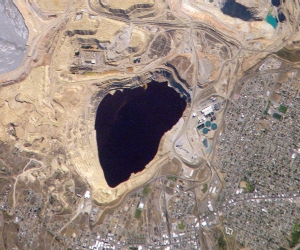Very neat eco-scientific finding!!! 

Just outside Butte, Montana lies a pit of greenish poison a mile and a half wide and over a third of a mile deep. It hasn't always been so - it was once a thriving copper mine appropriately dubbed “The Richest Hill in the World.” Over a billion tons of copper ore, silver, gold, and other metals were extracted from the rock of southwestern Montana, making the mining town of Butte one of the richest communities in the country, as well as feeding America’s industrial might for nearly a hundred years. By the middle of the twentieth century, the Anaconda Mining Company was in charge of virtually all the mining operations. When running underground mines became too costly in the 1950’s, Anaconda switched to the drastic but effective methods of “mountaintop removal” and open pit mining. Huge amounts of copper were needed to satisfy the growing demand for radios, televisions, telephones, automobiles, computers, and all the other equipment of America’s post-war boom. As more and more rock was excavated, groundwater began to seep into the pit, and pumps had to be installed to keep it from slowly flooding.
By 1983, the hill was so exhausted that the Anaconda Mining Company was no longer able to extract minerals in profitable amounts. They packed up all the equipment that they could move, shut down the water pumps, and moved on to more lucrative scraps of Earth. Without the pumps, rain and groundwater gradually began to collect in the pit, leaching out the metals and minerals in the surrounding rock. The water became as acidic as lemon juice, creating a toxic brew of heavy metal poisons including arsenic, lead, and zinc. No fish live there, and no plants line the shores. There aren’t even any insects buzzing about. The Berkeley Pit had become one of the deadliest places on earth, too toxic even for microorganisms. Or so it was thought.
In 1995, an analytic chemist named William Chatham saw something unusual in the allegedly lifeless lake......
CONTINUED: http://www.damninteresting.com/?p=961


Just outside Butte, Montana lies a pit of greenish poison a mile and a half wide and over a third of a mile deep. It hasn't always been so - it was once a thriving copper mine appropriately dubbed “The Richest Hill in the World.” Over a billion tons of copper ore, silver, gold, and other metals were extracted from the rock of southwestern Montana, making the mining town of Butte one of the richest communities in the country, as well as feeding America’s industrial might for nearly a hundred years. By the middle of the twentieth century, the Anaconda Mining Company was in charge of virtually all the mining operations. When running underground mines became too costly in the 1950’s, Anaconda switched to the drastic but effective methods of “mountaintop removal” and open pit mining. Huge amounts of copper were needed to satisfy the growing demand for radios, televisions, telephones, automobiles, computers, and all the other equipment of America’s post-war boom. As more and more rock was excavated, groundwater began to seep into the pit, and pumps had to be installed to keep it from slowly flooding.
By 1983, the hill was so exhausted that the Anaconda Mining Company was no longer able to extract minerals in profitable amounts. They packed up all the equipment that they could move, shut down the water pumps, and moved on to more lucrative scraps of Earth. Without the pumps, rain and groundwater gradually began to collect in the pit, leaching out the metals and minerals in the surrounding rock. The water became as acidic as lemon juice, creating a toxic brew of heavy metal poisons including arsenic, lead, and zinc. No fish live there, and no plants line the shores. There aren’t even any insects buzzing about. The Berkeley Pit had become one of the deadliest places on earth, too toxic even for microorganisms. Or so it was thought.
In 1995, an analytic chemist named William Chatham saw something unusual in the allegedly lifeless lake......
CONTINUED: http://www.damninteresting.com/?p=961
